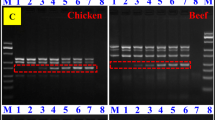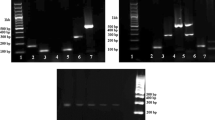Abstract
It is possible and risky for fur animal carcasses to be mixed into meat products, which is a potential danger for meat quality safety and human health. Therefore, meat validation of quality and constituents is crucial. A variety of methods have been developed to identify muscle tissues of different species. However, most of these methods have the disadvantages of poor repeatability, complex operation and low efficiency, and cannot simultaneously detect multiple species of muscle tissue. The purpose of this study was to construct a multiplex PCR protocol to detect the samples of mink, fox, and raccoon dog. In this study, the specific primers of mink, fox, and raccoon dog were designed according to the variable region sequence of mitochondrial cytochrome b (Cytb) gene. The primers showed good specificity and 50 ℃ was determined as the optimal annealing temperature. The lowest concentration of DNA template of mink, fox, or raccoon dog that could be determined simultaneously by a single tube was 1 pg/µL. Clinical tissue samples detect analysis test results showed that this method could identify whether the tissue samples of three fur animals were mixed from the muscles of chickens, ducks, dogs, cattle, sheep, pigs and rabbits in one PCR reaction simultaneously. In conclusion, the scheme exhibited the advantages of convenient operation, low cost, strong species specificity, high sensitivity, good stability, and repeatability. The systematic optimized inspection process can be applied to meat detection to ensure veterinary public health safety, which has important scientific significance, production, public health, and safety significance.









Similar content being viewed by others
Availability of Data and Materials
All data generated or analyzed during this study are included in this published article and its supplementary information files. The datasets are also available from the corresponding author on reasonable request.
References
Afshari A, Tavassoli M, Esmaelnejad B, Habibi GH, Esmaeilnia K (2021) Molecular characterization and phylogenetic analysis of pathogenic Theileria spp. isolated from cattle and sheep based on cytochrome b gene in Iran. Arch Razi Inst 76:243–252. https://doi.org/10.22092/ari.2020.341390.1431
Castresana J (2001) Cytochrome b phylogeny and the taxonomy of great apes and mammals. Mol Biol Evol 18:465–471. https://doi.org/10.1093/oxfordjournals.molbev.a003825
Fajardo V, Gonzalez I, Rojas M, Garcia T, Martin R (2010) A review of current PCR - based methodologies for the authentication of meats from game animal species. Trends Food Sci Technol 21:408–421. https://doi.org/10.1016/ji.tifs.2010.06.002
Girish PS, Anjaneyulu AS, Viswas KN, Shivakumar BM, Anand M, Patel M, Sharma B (2005) Meat species identification by polymerase chain reaction-restriction fragment length polymorphism (PCR - RFLP) of mitochondrial 12S rRNA gene. Meat Sci 70:107–112. https://doi.org/10.1016/j.meatsci.2004.12.004
He W, Zhang C, Yang J, Huang M, Yang J (2012) A quick multiplex PCR method for the identification of four meat ingredients in food products. Scientia Agricultura Sinica 45:1873–1880. https://doi.org/10.3864/j.issn.0578-1752.2012.09.024. ((In Chinese))
Izadpanah M, Mohebali N, Gorji ZE (2018a) Simple and fast multiplex PCR method for detection of species origin in meat products. J Food Sci Technol 55:698–703. https://doi.org/10.1007/s13197-017-2980-2
Izadpanah M, Mohebali N, Elyasi GZ, Farzaneh P, Vakhshiteh F, Shahzadeh Fazeli SA (2018b) Simple and fast multiplex PCR method for detection of species origin in meat products. J Food Sci Technol 55:698–703. https://doi.org/10.1007/s13197-017-2980-2
Junan R, Tingting D, Wensheng H (2017) A digital PCR method for identifying and quantifying adulteration of meat species in raw and processed food. PLoS ONE 12:e0173567. https://doi.org/10.1371/journal.pone.0173567
Karabasanavar NS, Singh SP, Kumar D, Shebannavar SN (2013) Development and application of highly specific PCR for detection of chicken (Gallus gallus) meat adulteration. Eur Food Res Technol 236:129–134. https://doi.org/10.1007/s00217-012-1868-7
Li P, Zhang D, Li H, Pang J, Guo H, Qiu J (2020) Establishment and application of a multiplex PCR for simultaneously detecting Escherichia coli, Salmonella, Klebsiella pneumoniae and Staphylococcus aureus in minks. Frontiers in Veterinary Science 7(eCollection 2020):588173. https://doi.org/10.3389/fvets.2020.588173
Liu Z (2022) Analysis on the situation of fur animal industry in 2021 and prospects for 2022. Animal Agriculture 4:32–36 ((In Chinese) Website of the thesis: http://202.194.143.28/rwt/CNKI/https/NNYHGLUDN3WXTLUPMW4A/kcms/detail/detail.aspx?dbcode=CJFQ&dbname=CJFDLAST2022&filename=SNCM202204005&v=MjczMTBQTXE0OUZZWVI4ZVgxTHV4WVM3RGgxVDNxVHJXTTFGckNVUjdpZVorUnRGeXZoVXI3Tk5pUElZN0c0SE4=)
Martinez I, Yman IM (1998) Species identification in meat products by RAPD analysis. Food Res Int 31:459–466. https://doi.org/10.1016/S0963-9969(99)00013-7
Matsunaga T, Chikuni K, Tanabe R, Muroyab S, Shibataa K, Yamadaa J, Shinmuraa Y (1999) A quick and simple method for the identification of meat species and meat products by PCR assay. Meat Sci 51:143–148. https://doi.org/10.1016/S0309-1740(98)00112-0
Mutalib SA, Muin NM, Abdullah A, Muin M, Abdullah A, Hassan O, Mustapha WAW, Sani NA, Maskat MY (2015) Sensitivity of polymerase chain reaction (PCR) - southern hybridization and conventional PCR analysis for Halal authentication of gelatin capsules. LWT Food Sci Technol 63:714–719. https://doi.org/10.1016/j.lwt.2015.03.006
Qamar Z, Alawami M, Mokhtar NFK, Nhari RMHR, Hanish I (2020) Current analytical methods for porcine identification in meat and meat products. Food Chem 324:126664. https://doi.org/10.1016/j.foodchem.2020.126664
Qin P, Qu W, Xu J, Qiao D, Yao L, Xue F, Chen W (2019) A sensitive multiplex PCR protocol for simultaneous detection of chicken, duck, and pork in beef samples. J Food Sci Technol 56:1266–1274. https://doi.org/10.1007/s13197-019-03591-2
Shahrooz R, Nurhidayatullaili MJ, Wageeh AY, Wan JB (2016) Identification of meat origin in food products - a review. Food Control 68:379–390. https://doi.org/10.1016/j.foodcont.2016.04.013
Shamsuddin M (2017) Preface: special issue on “genetic diversity of small ruminants in Asia.” Small Rumin Res 148:1. https://doi.org/10.1016/j.smallrumres.2017.02.017
Suyadi S, Murtika IL, Susilorini TE, Septian WA, Saputra F, Furqon A (2022) Genetic diversity of goats in East Java through analysis of the cytochrome B and cytochrome oxidase I genes in mitochondrial DNA. Small Rumin Res 209:106659. https://doi.org/10.1016/j.smallrumres.2022.106659
Wang D (2022) Statistical report on the number of mink, fox and raccoon dog taking skins in China in 2021. Westleather 44:2–4 (In Chinese) Website of the thesis: http://202.194.143.28/rwt/CNKI/https/NNYHGLUDN3WXTLUPMW4A/kcms/detail/detail.aspx?dbcode=CJFQ&dbname=CJFDLAST2022&filename=XBPG202204002&v=MTAzNjRSN2llWitSdEZ5dmhVTC9MUFMvYmFiRzRITlBNcTQ5RlpvUjhlWDFMdXhZUzdEaDFUM3FUcldNMUZyQ1U=)
Xu M, Liang Y, Liu Z (2016) Application status of meat and bone meal and prospect of processing fur animal carcass into meat and bone meal. Heilongjiang Anim Sci Vit Med 10:209–211 (https://doi.org/10.13881/j.cnki.hljxmsy.2016.1925 (In Chinese))
Xu R, Wei S, Zhou G, Ren J, Liu Z, Tang S, Pck C, Wu X (2018) Multiplex TaqMan locked nucleic acid real-time PCR for the differential identification of various meat and meat products. Meat Sci 137:41–46. https://doi.org/10.1016/j.meatsci.2017.11.003
Yang ML, Wang FY, Jiang DH, Ma ZF, Cui K (2017) Investigation on the operation of special economic animal industry in Shandong Province, China. Shangdong J Anim Sci Vet Med 8:47–49. https://doi.org/10.3969/j.issn.1007-1733.2017.08.035. ((In Chinese))
Yuttamol M, Worawidh W, Akira A, Manakorn S (2018) The novel primers for mammal species identification-based mitochondrial cytochrome b sequence implication for reserved wild animals in Thailand and endangered mammal species in Southeast Asia. Mitochondrial DNA A DNA Mapp Seq Anal 29:62–72. https://doi.org/10.1080/24701394.2016.1238902
Zhao X, Wang Y, Lan Q, Liu N, Chen R, Zhu Z, Liu O (2015) Real-time PCR detection of sheep derived materials in meat product. Sci Technol Food Industry 36:299–302+ 208 ((In Chinese))
Funding
This work was mainly supported by Major Science and Technology Innovation Project in Shandong Province (2023CXGC010704), Shandong Province Modern Agricultural Technology System Innovation Team Program (SDAIT-21–10), the Earmarked Fund for the Protection for the State Forest and Wild Animals (No. 2130211), and Funds of Shandong “Double Tops” program.
Author information
Authors and Affiliations
Contributions
Huijun Guo conceived and designed the experiments. Yao Pan, Xuemin Wang and Wenjie Ma are mainly responsible for experimental implementation. Hongmei Li, Jianhua Qiu and Yuxin Sun is mainly responsible for sample collection and helped to do some experiments. Jianhua Qiu, Xuemin Wang and Yao Pan wrote the manuscript. All authors have read and approved the final manuscript
Corresponding authors
Ethics declarations
Conflict of Interest
Yao Pan declares that he has no conflict of interest. Xuemin Wang declares that she has no conflict of interest. Wenjie Ma declares that he has no conflict of interest. Hongmei Li declares that she has no conflict of interest. Yuxin Sun declares that he has no conflict of interest. Jianhua Qiu declares that he has no conflict of interest. Huijun Guo declares that he has no conflict of interest.
Ethics Approval
Ethical approval was not required for the study because the sampling process did not harm the animals.
Competing Interest
The authors declare no competing interests
Additional information
Publisher's Note
Springer Nature remains neutral with regard to jurisdictional claims in published maps and institutional affiliations.
Rights and permissions
Springer Nature or its licensor (e.g. a society or other partner) holds exclusive rights to this article under a publishing agreement with the author(s) or other rightsholder(s); author self-archiving of the accepted manuscript version of this article is solely governed by the terms of such publishing agreement and applicable law.
About this article
Cite this article
Pan, Y., Wang, X., Ma, W. et al. Establishment and Application of Multiplex PCR Scheme for Simultaneously Distinguishing Muscle Tissues of Mink, Fox, and Raccoon Dog from Conventional Livestock and Poultry. Food Anal. Methods 17, 226–235 (2024). https://doi.org/10.1007/s12161-023-02560-y
Received:
Accepted:
Published:
Issue Date:
DOI: https://doi.org/10.1007/s12161-023-02560-y




